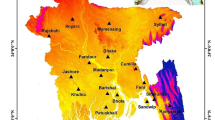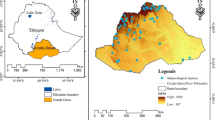Abstract
A long time series in crop yield is usually expressed as a long-term trend and a short-term fluctuation due to agricultural technological advance and climatic anomaly. The real climate risk is related to the short-term fluctuation in crop yield. In the paper, the climate risk of maize yield response to long-term climate variables is tested with the long time series (1961–2015) by a trend base line method. The long time series of maize yield is divided into short-term fluctuating meteorological yield and long-term trend yield. The long time series of climate variables are also divided into fluctuating variables and trend variables. After that, Pearson correlation analysis between fluctuating maize yield and fluctuating climate variables is used to identify risk factor causing maize yield fluctuation. Our results reveal that the main risk factors are night-time precipitation and extreme high temperature in growing season. Comparing climate risks in maize-producing provinces, much more climate risks are identified in some regions such as Liaoning province. The results provide useful information for reducing maize yield loss under climatic change.



Similar content being viewed by others
References
Fang SB (2011) Exploration of method for discrimination between trend crop yield and climatic fluctuant yield. J Nat Disasters 20:13–19
Fang SB, Qi Y, Han GJ, Li QX, Zhou GS (2016) Changing trends and abrupt features of extreme temperature in Mainland China from 1960 to 2010. Atmosphere 7:22
Fang SB, Qi Y, Yu WG, Liang HY (2017) Change in temperature extremes and its correlation with mean temperature in mainland China from 1960 to 2015. Int J Climatol 37:3910–3918
Guo EL, Zhang JQ, Wang YF, Si H, Zhang F (2016) Dynamic risk assessment of waterlogging disaster for maize based on CERES-Maize model in Midwest of Jilin province, China. Nat Hazards 83:1747–1761
Jia LS, Teng WZ, Pan W, Xue Y, He HD (2014) Correlation analysis of synchronization flow at a traffic bottleneck. Nonlinear Dyn 78:1801–1809
Jiang T, Zhang Q, Blender R, Fraedrich K (2005) Yangtze delta floods and droughts of the last millennium: abrupt changes and long term memory. Theor Appl Climatol 82:131–141
Lobell DB, Field CB (2007) Global scale climate–crop yield relationships and the impacts of recent warming. Environ Res Lett 2:014002
Lobell DB, Schlenker W, Costa-Roberts J (2011) Climate trends and global crop production since 1980. Science 333:616–620
Ma SQ, Xi ZX, Wang Q (2003) Risk evaluation of cold damage to corn in Northeast China. J Nat Disasters 12:137–142
Meng QF, Hou P, Lobell DB, Wang HF, Cui ZL, Zhang FS, Chen XP (2014) The benefits of recent warming for maize production in high latitude China. Clim Change 122:341–349
Niu XK, Xie RZ, Liu X, Zhang FL, Li SK, Gao SJ (2013) Maize yield gains in Northeast China in the last six decades. J Integr Agric 12:630–637
Osborne TM, Wheeler TR (2013) Evidence for a climate signal in trends of global crop yield variability over the past 50 years. Environ Res Lett 8:024001
Ranum P, Pena-Rosas JP, Garcia-Casal MN (2014) Global maize production, utilization, and consumption. Ann NY Acad Sci 1312:105–112
Ray DK, Gerber JS, MacDonald JK, West PC (2015) Climate variation explains a third of global crop yield variability. Nat Commun 6:5989
Shiferaw B, Prasanna BM, Hellin J, Bänziger M (2011) Crops that feed the world 6. Past successes and future challenges to the role played by maize in global food security. Food Sec 3:307–327
Sirotenko OD, Pavlova VN (2010) A new approach to identifying the weather–crop yield functionals for assessing climate change consequences. Rus Meteorol Hydrol 35:142–148
Tao FL, Yokozawa M, Xu YL, Hayashi Y, Zhang Z (2006) Climate changes and trends in phenology and yields of field crops in China, 1981–2000. Agric For Meteorol 138:82–92
Tao FL, Zhang Z, Zhang S, Rotter RP (2016) Variability in crop yields associated with climate anomalies in China over the past three decades. Reg Environ Change 16:1715–1723
Wang DL, Zhong XL, Li MS, Yang X (2006) Impacts of main agro-meteorological disasters on China agriculture since the 1990s and the disaster mitigation strategies. J Catastr 21:18–23
Wei TY, Cherry TL, Glomrød S, Zhang TY (2014) Climate change impacts on crop yield: evidence from China. Sci Total Environ 499:133–140
Xiao DP, Tao FL (2016) Contributions of cultivar shift, management practice and climate change to maize yield in North China Plain in 1981–2009. Int J Biometeorol 60:1111–1122
Zhang JQ (2004) Risk assessment of drought disaster in the maize-growing region of Songliao Plain, China. Agric Ecosyst Environ 102:133–153
Zhang TY, Huang Y (2013) Estimating the impacts of warming trends on wheat and maize in China from 1980 to 2008 based on county level data. Int J Climatol 33:699–708
Zhang Q, Zhang JQ, Guo EL, Yan DH, Sun ZY (2015) The impacts of long-term and year-to-year temperature change on corn yield in China. Theor Appl Climatol 119:77–82
Acknowledgements
The study is supported by the National Natural Science Fund of China (No. 41571175, 41330531, 41671362) and the special funds for basic research and operation of Chinese Academy of Meteorological Science (2017Y003, 132020010406). We thank Leonie Seabrook, PhD, from Liwen Bianji, Edanz Group China (www.liwenbianji.cn/ac), for editing the English text of a draft of this manuscript.
Author information
Authors and Affiliations
Corresponding author
Additional information
Publisher's Note
Springer Nature remains neutral with regard to jurisdictional claims in published maps and institutional affiliations.
Rights and permissions
About this article
Cite this article
Ji, Y., Zhou, G., Wang, L. et al. Identifying climate risk causing maize (Zea mays L.) yield fluctuation by time-series data. Nat Hazards 96, 1213–1222 (2019). https://doi.org/10.1007/s11069-019-03605-4
Received:
Accepted:
Published:
Issue Date:
DOI: https://doi.org/10.1007/s11069-019-03605-4




